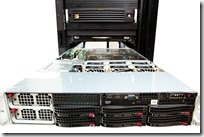 We often get questions from our customers, both ANSYS product and CUBE HVPC users, on how to get their jobs to run faster. Should they get better disk drives or focus on CPU performance. We have found that disk drive performance often gets the blame when it is undeserving. To help figure this out, the first thing we do t is look at the output from an ANSYS Mechanical/Mechanical APDL run. Here is an email, slightly modified to leave the user anonymous, that shows our most recent case of this:
We often get questions from our customers, both ANSYS product and CUBE HVPC users, on how to get their jobs to run faster. Should they get better disk drives or focus on CPU performance. We have found that disk drive performance often gets the blame when it is undeserving. To help figure this out, the first thing we do t is look at the output from an ANSYS Mechanical/Mechanical APDL run. Here is an email, slightly modified to leave the user anonymous, that shows our most recent case of this:
From: David Mastel – PADT, Inc.
To: John Engineering
Subject: Re: Re: Re: Relatively no difference between SSD vs. SAS2 15k RPM solve times?
Hi John, so I took a look at your ANSYS Mechanical output files – Based on the problem you are running the machine is Compute Bound. Here is the process on how I came to that conclusion. Additionally, at the end of this email I have included a few recommendations.
All the best,
David
Example 1:
The bottom section of an ANSYS out file for a 2 x 240GB
Samsung 843 SSD RAID0 array:
Total CPU time for main thread : 105.9 seconds
Total CPU time summed for all threads : 119.1 seconds
Elapsed time spent pre-processing model (/PREP7) : 0.0 seconds
Elapsed time spent solution – preprocessing : 10.3 seconds
Elapsed time spent computing solution : 83.5 seconds
Elapsed time spent solution – postprocessing : 3.9 seconds
Elapsed time spent post-processing model (/POST1) : 0.0 seconds
Equation solver computational rate : 319444.9 Mflops
Equation solver effective I/O rate : 26540.1 MB/sec
Maximum total memory used : 48999.0 MB
Maximum total memory allocated : 54896.0 MB
Maximum total memory available : 128 GB
+—— E N D D I S T R I B U T E D A N S Y S S T A T I S T I C S ——-+
*—————————————————————————*
| |
| DISTRIBUTED ANSYS RUN COMPLETED |
| |
|—————————————————————————|
| |
| Release 14.5.7 UP20130316 WINDOWS x64 |
| |
|—————————————————————————|
| |
| Database Requested(-db) 512 MB Scratch Memory Requested 512 MB |
| Maximum Database Used 447 MB Maximum Scratch Memory Used 4523 MB |
| |
|—————————————————————————|
| |
| CP Time (sec) = 119.01 Time = 15:41:54 |
| Elapsed Time (sec) = 117.000 Date = 10/21/2013 |
| |
*—————————————————————————*
For a quick refresher on what it means to be compute bound or I/O bound, let’s review what ANSYS Mechanical APDL tells you.
When looking at your ANSYS Mechanical APDL (this file is created during the solve in ANSYS Mechanical, since ANSYS Mechanical is just running ANSYS Mechanical APDL behind the scenes) out files; I/O bound and Compute bound are essentially the following:
I/O Bound:
- When Elapsed Time greater than Main Thread CPU time
Compute Bound:
- When Elapsed time is equals (approx) to Main Thread CPU time
Example 2:
CUBE HVPC – Samsung 843 – 240GB SATA III SSD 6Gbps – RAID 0
Total CPU time for main thread : 105.9 seconds
Elapsed Time (sec) : 117.000 seconds
CUBE HVPC – Hitachi 600GB SAS2 15k RPM – RAID 0
Total CPU time for main thread : 109.0 seconds
Elapsed Time (sec) : 120.000 seconds
Recommendations for a CPU compute bound ANSYS server or workstation:
When computers are compute bound I normally recommend the following.
- Add faster processors – check!
- Use more cores for solve – I think you are in the process of doing this now?
- Instead of running SMP go DMP – unable to use DMP with your solve
- Add an Accelerator card (NVidia Tesla K20x). Which unfortunately does not help in your particular solving situation.
Please let me know if you need any further information:
David
David Mastel
Manager, Information Technology
Phoenix Analysis & Design Technologies
7755 S. Research Dr, Suite 110
Tempe, AZ 85284
David.Mastel@PADTINC.com
The hardware we have available changes every couple of months or so, but right now, for a user who is running this type of ANSYS Mechanical/Mechanical APDL model, we are recommending the following configuration:
CUBE HVPC Recommended Workstation for ANSYS Mechanical: CUBE HVPC w16-KGPU
|
CUBE HVPC |
COST |
CHASIS |
PROCESSOR |
CORES |
MEMORY |
|
CUBE HVPC |
$ 16,164.00 |
Mid-Tower |
Dual Socket INTEL XEON |
16 = 2 x 8 |
128GB DDR3-1866 ECC REG |
|
STORAGE |
RAID |
GRAPHICS |
ACCELERATOR |
OS |
OTHER |
|
4 x 240GB |
SMC LSI 2208 |
NVIDIA |
NVIDIA |
Microsoft |
ANSYS R14.5.7 |
![]()
Here are some references to the some basic information and the systems we recommend:
http://www.intel.com
http://en.wikipedia.org/wiki/CPU_bound
http://en.wikipedia.org/wiki/I/O_bound
http://www.supermicro.com
http://www.cube-hvpc.com
http://www.ansys.com
http://www.nvidia.com


















